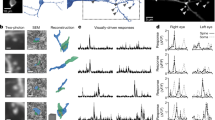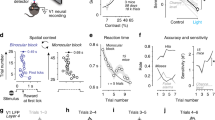Abstract
Attention is a critical component of perception1. However, the mechanisms by which attention modulates neuronal communication to guide behaviour are poorly understood. To elucidate the synaptic mechanisms of attention, we developed a sensitive assay of attentional modulation of neuronal communication. In alert monkeys performing a visual spatial attention task, we probed thalamocortical communication by electrically stimulating neurons in the lateral geniculate nucleus of the thalamus while simultaneously recording shock-evoked responses from monosynaptically connected neurons in primary visual cortex. We found that attention enhances neuronal communication by increasing the efficacy of presynaptic input in driving postsynaptic responses, by increasing synchronous responses among ensembles of postsynaptic neurons receiving independent input, and by decreasing redundant signals between postsynaptic neurons receiving common input. The results demonstrate that attention finely tunes neuronal communication at the synaptic level by selectively altering synaptic weights, enabling enhanced detection of salient events in the noisy sensory environment.
This is a preview of subscription content, access via your institution
Access options
Subscribe to this journal
Receive 51 print issues and online access
$199.00 per year
only $3.90 per issue
Buy this article
- Purchase on Springer Link
- Instant access to full article PDF
Prices may be subject to local taxes which are calculated during checkout




Similar content being viewed by others
References
Posner, M. I., Synder, C. R. R. & Davidson, B. J. Attention and the detection of signals. J. Exp. Psychol. 109, 160–174 (1980)
Van Voorhis, S. & Hillyard, S. A. Visual evoked potentials and selective attention to points in space. Percept. Psychophys. 22, 54–62 (1977)
Moran, J. & Desimone, R. Selective attention gates visual processing in the extrastriate cortex. Science 229, 782–784 (1985)
Heinze, H. J. et al. Combined spatial and temporal imaging of brain activity during visual selective attention in humans. Nature 372, 543–546 (1994)
Ito, M. & Gilbert, C. D. Attention modulates contextual influences in the primary visual cortex of alert monkeys. Neuron 22, 593–604 (1999)
Kelly, S. P., Gomez-Ramirez, M. & Foxe, J. J. Spatial attention modulates initial afferent activity in human primary visual cortex. Cereb. Cortex 18, 2629–2636 (2008)
McAdams, C. J. & Reid, R. C. Attention modulates the responses of simple cells in monkey primary visual cortex. J. Neurosci. 25, 11023–11033 (2005)
Thiele, A., Pooresmaeili, A., Delicato, L. S., Herrero, J. L. & Roelfsema, P. R. Additive effects of attention and stimulus contrast in primary visual cortex. Cereb. Cortex 19, 2970–2981 (2009)
Vanduffel, W., Tootell, R. B. & Orban, G. A. Attention-dependent suppression of metabolic activity in the early stages of the macaque visual system. Cereb. Cortex 10, 109–126 (2000)
O'Connor, D. H., Fukui, M. M., Pinsk, M. A. & Kastner, S. Attention modulates responses in the human lateral geniculate nucleus. Nature Neurosci. 5, 1203–1209 (2002)
McAlonan, K., Cavanaugh, J. & Wurtz, R. H. Guarding the gateway to cortex with attention in visual thalamus. Nature 456, 391–394 (2008)
Spitzer, H., Desimone, R. & Moran, J. Increased attention enhances both behavioral and neuronal performance. Science 240, 338–340 (1988)
McAdams, C. J. & Maunsell, J. H. Attention to both space and feature modulates neuronal responses in macaque area V4. J. Neurophysiol. 83, 1751–1755 (2000)
Fries, P., Reynolds, J. H., Rorie, A. E. & Desimone, R. Modulation of oscillatory neuronal synchronization by selective visual attention. Science 291, 1560–1563 (2001)
Lakatos, P., Karmos, G., Mehta, A. D., Ulbert, I. & Schroeder, C. E. Entrainment of neuronal oscillations as a mechanism of attentional selection. Science 320, 110–113 (2008)
Cohen, M. R. & Maunsell, J. H. Attention improves performance primarily by reducing interneuronal correlations. Nature Neurosci. 12, 1594–1600 (2009)
Mitchell, J. F., Sundberg, K. A. & Reynolds, J. H. Spatial attention decorrelates intrinsic activity fluctuations in macaque area V4. Neuron 63, 879–888 (2009)
Pestilli, F., Carrasco, M., Heeger, D. J. & Gardner, J. L. Attentional enhancement via selection and pooling of early sensory responses in human visual cortex. Neuron 72, 832–846 (2011)
Zénon, A. & Krauzlis, R. J. Attention deficits without cortical neuronal deficits. Nature 489, 434–437 (2012)
Bullier, J. & Henry, G. H. Ordinal position and afferent input of neurons in monkey striate cortex. J. Comp. Neurol. 193, 913–935 (1980)
Chen, Y. et al. Task difficulty modulates the activity of specific neuronal populations in primary visual cortex. Nature Neurosci. 11, 974–982 (2008)
Luck, S. J., Chelazzi, L., Hillyard, S. A. & Desimone, R. Neural mechanisms of spatial selective attention in area V1, V2, and V4 of macaque visual cortex. J. Neurophysiol. 77, 24–42 (1997)
Motter, B. C. Focal attention produces spatially selective processing in visual cortical areas V1, V2, and V4 in the presence of competing stimuli. J. Neurophysiol. 70, 909–919 (1993)
Yoshor, D., Ghose, G. M., Bosking, W. H., Sun, P. & Maunsell, J. H. R. Spatial attention does not strongly modulate neuronal responses in early human visual cortex. J. Neurosci. 27, 13205–13209 (2007)
Usrey, W. M. The role of spike timing for thalamocortical processing. Curr. Opin. Neurobiol. 12, 411–417 (2002)
Usrey, W. M., Alonso, J.-M. & Reid, R. C. Synaptic interactions between thalamic inputs to simple cells in cat visual cortex. J. Neurosci. 20, 5461–5467 (2000)
Zohary, E., Shadlen, M. N. & Newsome, W. T. Correlated neuronal discharge rate and its implications for psychophysical performance. Nature 370, 140–143 (1994)
Stratford, K. J., Tarczy-Hornoch, K., Martin, K. A. C., Bannister, N. J. & Jack, J. J. B. Excitatory synaptic inputs to spiny stellate cells in cat visual cortex. Nature 382, 258–261 (1996)
Herrero, J. L. et al. Acetylcholine contributes through muscarinic receptors to attentional modulation in V1. Nature 454, 1110–1114 (2008)
Disney, A. A., Aoki, C. & Hawken, M. J. Gain modulation by nicotine in macaque V1. Neuron 56, 701–713 (2007)
Briggs, F. & Usrey, W. M. A fast, reciprocal pathway between the lateral geniculate nucleus and visual cortex in the macaque monkey. J. Neurosci. 27, 5431–5436 (2007)
Briggs, F. & Usrey, W. M. Parallel processing in the corticogeniculate pathway of the macaque monkey. Neuron 62, 135–146 (2009)
Skottun, B. C. et al. Classifying simple and complex cells on the basis of response modulation. Vision Res. 31, 1078–1086 (1991)
Brody, C. D. Slow covariations in neuronal resting potentials can lead to artefactual fast cross-correlations in their spike trains. J. Neurophysiol. 80, 3345–3351 (1998)
Acknowledgements
We thank K. E. Neverkovec, D. J. Sperka and R. Oates-O’Brien for technical and veterinary assistance. This work was supported by National Institutes of Health grants EY18683 (F.B.), EY013588 (W.M.U.), MH055714 (G.R.M.) and NSF grants BCS-0727115 and 1228535 (G.R.M. and W.M.U.).
Author information
Authors and Affiliations
Contributions
F.B., G.R.M. and W.M.U. designed the experiments. F.B. conducted the experiments and performed the data analyses in collaboration with G.R.M. and W.M.U. F.B., G.R.M. and W.M.U. wrote the manuscript.
Corresponding author
Ethics declarations
Competing interests
The authors declare no competing financial interests.
Supplementary information
Supplementary Information
This file contains Supplementary Figures 1-2. (PDF 178 kb)
Rights and permissions
About this article
Cite this article
Briggs, F., Mangun, G. & Usrey, W. Attention enhances synaptic efficacy and the signal-to-noise ratio in neural circuits. Nature 499, 476–480 (2013). https://doi.org/10.1038/nature12276
Received:
Accepted:
Published:
Issue Date:
DOI: https://doi.org/10.1038/nature12276
This article is cited by
-
Cognitive load associates prolonged P300 latency during target stimulus processing in individuals with mild cognitive impairment
Scientific Reports (2023)
-
Priority coding in the visual system
Nature Reviews Neuroscience (2022)
-
State-dependent effects of neural stimulation on brain function and cognition
Nature Reviews Neuroscience (2022)
-
Neuronal modulation in the mouse superior colliculus during covert visual selective attention
Scientific Reports (2022)
-
Cortical ensemble activity discriminates auditory attentional states
Molecular Brain (2019)
Comments
By submitting a comment you agree to abide by our Terms and Community Guidelines. If you find something abusive or that does not comply with our terms or guidelines please flag it as inappropriate.



